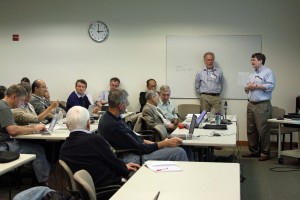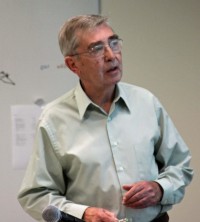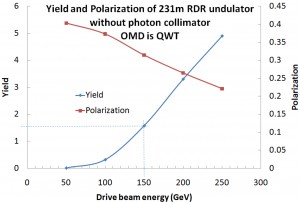
Discussions of the proposal to relocate the positron source during the Baseline Assessment Workshop at SLAC in January 2011.
Three major changes to the Reference Design Report (RDR) baseline have previously been adopted. Today, I announce the approval of the fourth and final top-level baseline change that has been proposed by the Global Design Effort project managers. The undulator-based positron source will be relocated from the 150 GeV energy point to the exit of the main electron linac, resulting in several system integration improvements. Our motivations behind making these changes is to evolve the design for the Technical Design Report such that we improve elements of the design and, most importantly, such that we find ways to reduce costs to compensate known areas of cost growth.
A number of important systems integration benefits result from moving the positron source and were listed in the original SB2009 proposal:
- The undulator source can be better integrated into the upstream area of the beam delivery system (BDS), where more tunnel space and more freedom of lattice design are available than in the main linac.
- Machine protection systems for the smaller acceptance undulator and BDS beamlines can be effectively combined into a single system, located immediately downstream of the main linac.
- All sources of restricted energy bandwidth are now localised in the central region, leaving both the main superconducting radiofrequency linac as systems with nearly identical contiguous high bandwidth. This greatly facilitates their commissioning and tuning.
- Moving the positron target and capture system to the end of the linac consolidates all the high-radiation environment systems within the central area, which is expected to be beneficial for certain host sites (radiation safety and environmental impact).
- A large energy overhead is available to drive the undulator source, which allows operational margin for the early commissioning in the event that the maximum-performance of the main linacs system is not achieved (i.e., maximum gradient at full beam loading).

Ewan Paterson discusses central integration for the relocated positron source during the Baseline Assessment Workshop at SLAC.
The change in the location of the positron source gives increased flexibility for linac operations and upgrades, and results in some cost savings by eliminating duplication of some underground volume and systems. However, at lower energies (for example, below 300 GeV), modifications such as including ten-hertz operation will be required to maintain high luminosity. Accommodating ten-hertz operation will increase costs and compensate some of the overall cost savings.
The new baseline proposal includes a description of the possible low-energy operations scheme (ten-hertz alternate pulse running) that is consistent with the RDR. “Physics runs are possible for every energy above √s = 200 GeV”. The positron yield is greater than 1.5 over this energy range and enables operation with the RDR parameters or the ‘reduced beam parameter set’.
The design yield is 1.5 at 150 GeV (corresponding to 300 GeV centre-of-mass operation). Below 150 GeV, the yield reduces until it becomes 1.0 at 125 GeV (250 GeV centre-of-mass). At this and lower beam energies, where the yield is predicted to be less than 1 for these parameters, it is proposed to switch to the ten-hertz alternate pulse.
To enable the ten-hertz operation, a variety of changes will be necessary, including modifying the damping rings magnet lattice and damping wigglers to double the damping rate, increasing the radiofrequency power, as well as making some modifications to the electron source and adding a beamline and switched magnet system. The auxiliary positron source will be integrated with the main power source, eliminating the separate standalone source. Some alternatives to the ten-hertz solution have been suggested, but require study.
Now that all the top level changes to the baseline have been determined, the detailed design work will be carried out to develop an integrated design for the Technical Design Report. The GDE process of developing the new baseline has been successful. There are still other changes to be considered and the detailed design is yet to be carried out, but we now should have a clear path towards developing a well-understood and integrated ILC technical design.



Recent Comments